Majidova Y. N.1, Rakhmonov I. A.2, Azimova N. M.1
1Department of Neurology, Pediatric Neurology with Medical Genetics of the Tashkent Pediatric Medical Institute, Uzbekistan
2Basic Doctoral Student of the Department of Neurology and MI, Uzbekistan
Copyright © 2024 The Author(s). Published by Scientific & Academic Publishing.
This work is licensed under the Creative Commons Attribution International License (CC BY).
http://creativecommons.org/licenses/by/4.0/

Abstract
The article examines in detail and compares the results of a survey of the specifics of somatic and neurotic disorders in men, depending on the duration of infertility. A burdened premorbid background and psycho-emotional disorders in the form of neurasthenia significantly prevailed in men with infertility, while the most common complaints of a neurasthenic nature were irritability, general weakness and sleep problems.
Keywords:
Infertility, Men, Psycho-emotional disorders
Cite this paper: Majidova Y. N., Rakhmonov I. A., Azimova N. M., Neurological Disorders in Men in Infertile Marriages, American Journal of Medicine and Medical Sciences, Vol. 14 No. 3, 2024, pp. 586-591. doi: 10.5923/j.ajmms.20241403.10.
1. Introduction
Infertile marriage is a problem on both the psychological and social spectrum in Uzbekistan, where starting a family is associated with procreation; therefore, any problems in this area, the absence of a timely desired pregnancy, lead to a state of chronic stress in the family, which is fraught with family conflicts, subsequently with the development of sexual dysfunctions, neurotic and somatic disorders. Infertility becomes a cause of conflicts in married couples; the number of marriage breakdowns is 6-7 times higher for people who do not have the opportunity to have children compared to couples with children [1-3]. There is often a loss of meaning in life, loss of interest in the profession, as well as the development of depression and psychosexual dysfunction. It follows from this that the tasks of maintaining the optimal state of the reproductive system are the main vector in organizing the optimal quality of life [4-11].
2. Materials and Research Methods
To fulfill the goals and objectives set for the dissertation research, 80 men from 18 to 33 years old were examined, from partner couples who had been in infertile marriage for more than 2 years, the control group consisted of 30 practically healthy men. We divided the men, according to the nature of the infertile marriage, into 2 groups: the 1st group (main) consisted of 50 men with various fertility disorders, and the 2nd group (comparison) consisted of 30 men with normal reproductive function in whom the cause of the infertile marriage was the female factor. In addition, a control group was examined, which consisted of 30 practically healthy men, married and with children.In addition, in order to study in detail and compare the results of the examination of the specifics of somatic and neurotic reactions of men depending on the duration of infertility, we divided the patients based on the recommendation of J. Mert (1998) [12]. 3 groups were identified (Fig. 1): group A - males married for 12 months to 2 years, group B - married men without children from 3 to 5 years and group B - men who have been in an infertile marriage for more than 6 years.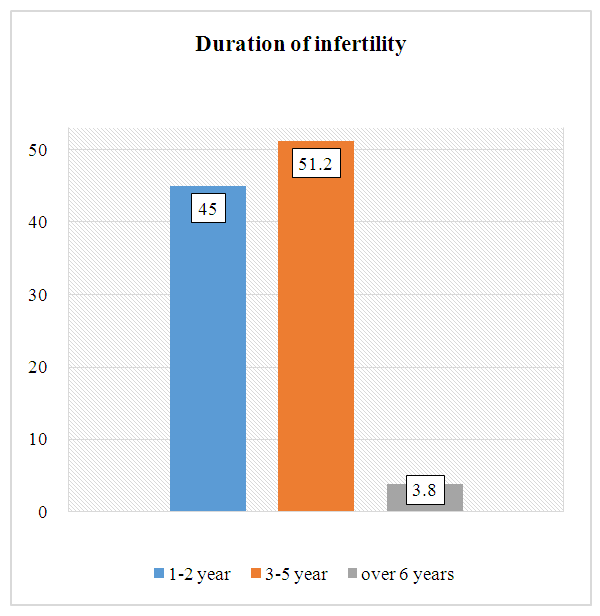 | Figure 1. Distribution of patients by duration of infertility |
3. Results
Our research has proven that in 91.3% of cases in the first marriage, while in the second marriage it is 8.7%. In the main group, 86% of those studied had a first marriage, while in 14% of cases there was a second marriage. In the comparison group, the cause of infertility was the presence of problems in the reproductive system of females; it is worth noting that all men in this group were in their first marriage. It is also worth emphasizing that the incidence of second marriage increases as the age group of males increases.One of the factors in the development of male infertility is the negative impact of working conditions, or the lack of a permanent place of work. Based on the results of the characteristics of the medical and social type, among all male respondents it was noted in 87.5% of cases that they had a permanent place of work, while in 12.5% of cases the respondents did not have a job. Of the group of males with a profession, drivers were noted in 15% of cases, electricians in 8.8% of cases, workers in management positions in 7.5% of cases, mechanics in 8.8% of cases, builders in 7.5% of cases, and collaborators in 5% of cases. centers, in 5% of cases engineers, in 5% of cases security guards and in 2.5% of cases lawyers, etc.Of the male respondents, in 2.5% of cases, confirmation of the presence of a high level of psycho-emotional stress was noted, while psycho-emotional stress was noted in every tenth, the presence of vibration exposure was noted in 16.3% of cases, while in every fifth case the presence of harmful substances, it is worth noting that in 11.3% of cases, shift work was noted, in 3.7% of cases, exclusively night work was noted, and in 23.7% of cases, a high number of business trips was noted.Even if 26.2% of those studied have infertility, this group of people considers themselves healthy and have no complaints about their general condition, while in 42.5% of cases the state of health was assessed as good, in 28.8% of cases it was assessed as satisfactory and in 2.5% of cases as unsatisfactory. It was found that of the surveyed males, 55% of them do not have diseases associated with the genitourinary system, in 2.5% of cases the presence of benign prostatic hyperplasia is noted, in every fifth of those studied there is chronic inflammation of the prostate, and also in every fifth the presence of varicocele and in 3.8% was detected by the presence of urolithiasis.In 85.2% of cases, therapy for infertility is carried out in outpatient settings, while in 14.8% of cases, inpatient therapy was noted. In 21.9% of cases, the respondents had higher education, while incomplete higher education was present in 6.8% of cases, and specialized secondary education was noted in 8.6% of cases.When analyzing patient complaints, the emphasis was placed on the fact that the complaints, which were a manifestation of any pathological syndromes, did not have an objective clinical picture. It is worth noting that these syndromes have active progress as the period of infertility increases. It is worth noting that this group of people had a direct dependence on the exact characteristics of the results of studies of the reproductive system regarding infertility and had pronounced psychosomatic aspects of origin.Thus, at the first consultation, more than 90% of men in infertile marriages presented various types of complaints, while in the main group this figure was 98%, and in the comparison group 80%. Both patients in the main and control groups complained of psycho-emotional disorders - 96% and 76.7%, respectively, while the difference with the control group (33%) was significant. Another common complaint among men with infertility was general weakness (76%), while in the group with the female factor of infertile marriage, general weakness bothered only 40% of patients. Headaches were noted only in 38% of cases in males with infertility, in 33.3% of cases in infertile marriages, in every fifth male representative in an infertile marriage due to the female factor of infertility.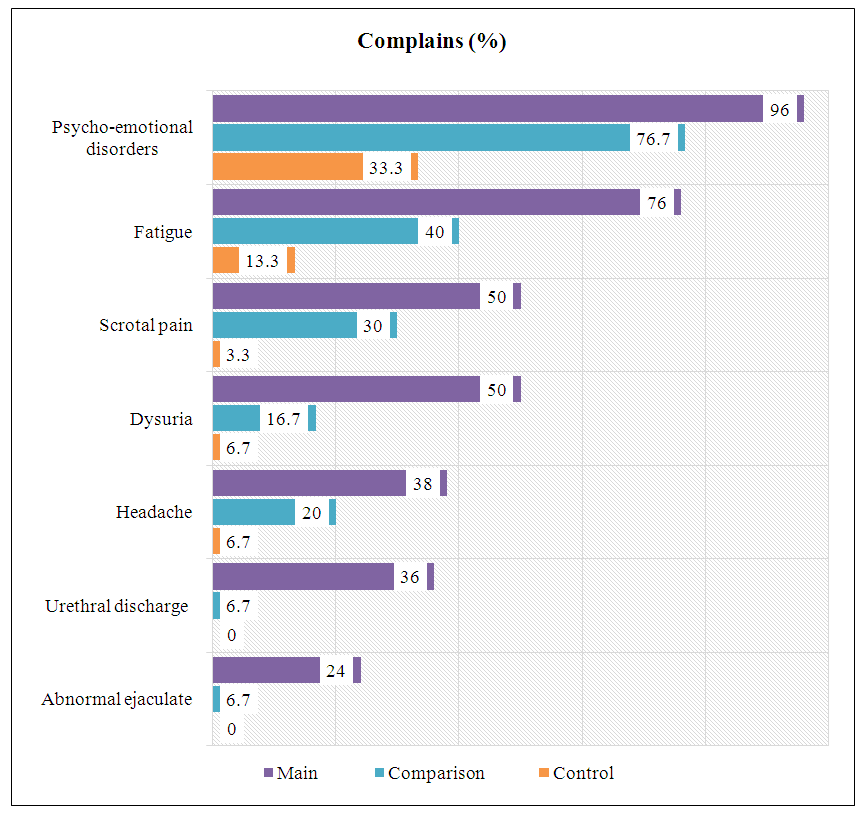 | Figure 2. Complaints made by patients during the survey |
In addition to basic complaints, males in infertile marriages had complaints of dysfunction of the genitourinary system; it is worth noting that the presence of changes in the rhythm of urination were identified already at the first stage of the examination, while the presence of pain during urination was also noted in 50% of cases, with In this case, the presence of pathological discharge from the urethra was noted in 36% of cases, which is 18 people; the presence of pain in the testicles and pelvic area was noted in 50% of cases, which is 34 people; Dyschromia of the ejaculate and a change in its consistency were noted in 24% of cases, which is 12 people. What is characteristic, as can be seen from Figure 1, in the group with female infertility factor there were also complaints about genitourinary disorders, especially pain in the genitourinary area, and as we see, the difference with the control group was statistically significant.Psycho-emotional disorders in the form of neurasthenia significantly prevailed in men with infertility, while the most common complaints of a neurasthenic nature were irritability, general weakness and sleep disturbance. These complaints were observed significantly more often in the main group (90%, 82% and 62%, respectively), while in the comparison group these figures were 50%, 36.7% and 33.3%, respectively. Complaints such as a feeling of tension were more common in men in infertile marriages than in healthy ones, but there was no statistical difference between the main (30%) and comparison groups (20%).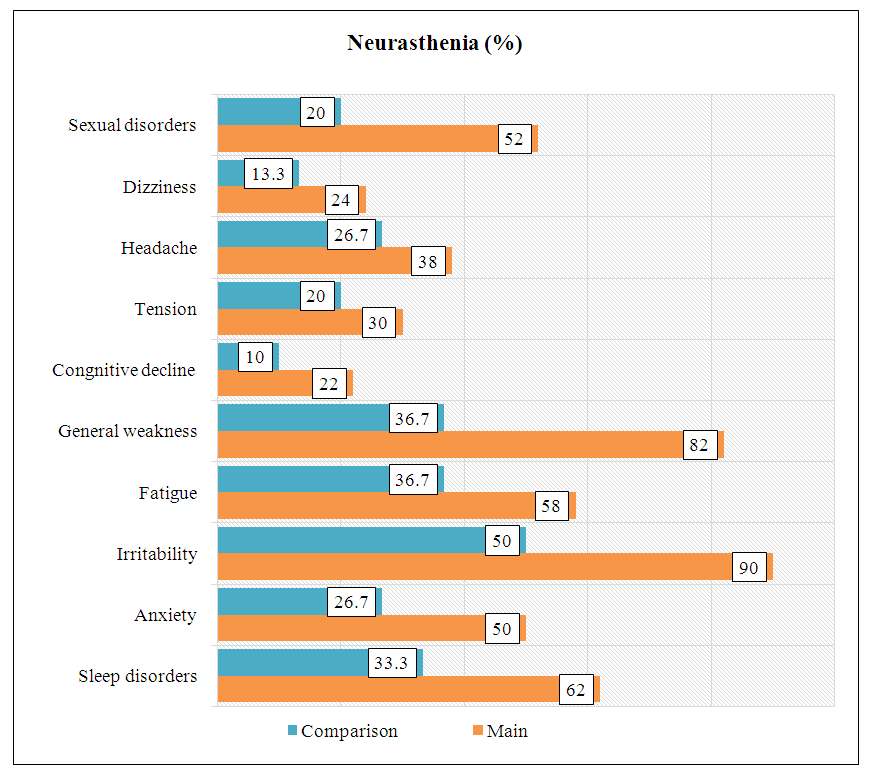 | Figure 3. Neurological complaints from patients |
Decreased cognitive function was more often complained of in the group of men with impaired fertility, while no difference was observed in the control and comparison groups and this indicator was almost equal. It is worth noting that these complaints in the studied individuals did not resolve after rest. Individuals with neurasthenia also noted high sensitivity to high-pitched sounds, noise, and bright lights; these manifestations were also noted in most of the patients we studied.In the majority of patients with neurasthenia, tension headaches were recorded in 36.3% of cases, the presence of a neurasthenic helmet was noted in 24.1% of cases, and heaviness in the head was noted in 75.9% of cases.Dysfunction of a sexual nature occupied the main level among all clinical aspects of neurasthenia; in males, this disorder was manifested by premature ejaculation and weak erection, as well as a low level of sexual desire.Among our patients, sexual disorders significantly predominated in the group with male infertility (52% of men), however, 20% of men in infertile marriages due to the female factor also complained of recurrent sexual disorders.The nature of the course of neurasthenia in our patients can be divided into 2 types: hyposthenic and hypersthenic. The first type was characterized by fatigue, decreased performance, as well as drowsiness in the first half of the day; in this category of patients, signs of depressive disorders predominated, and especially in patients of the main group who were in a barren marriage for more than 5 years, neurasthenia took on a chronic nature, which was manifested by asthenodepressive syndrome. The second type, hypersthenic, predominated most often in men in the comparison group; they were most often characterized by short temper, excitability, as well as sleep disturbances in the form of difficulty falling asleep, while anxiety disorders with signs of impaired autonomic reactivity predominated in this category of patients. It should be noted that the patients in the comparison group, who were in an infertile marriage for more than 5 years, had a characteristic “irritable weakness”, which included signs of both hypersthenic and hyposthenic types of neurasthenia.As for sleep disorders, in men in infertile marriages, they were mainly manifested by inadequate and superficial sleep with a large number of vivid dreams, as well as difficulties in falling asleep. Patients complained of a lack of vigor after waking up, while their general health improved at lunchtime, with a further deterioration in the afternoon.Taking into account a number of effects from infectious pathologies, namely infections during childhood, which could affect the reproductive system, we carried out a series of comparative analyzes of the infectious history of the subjects.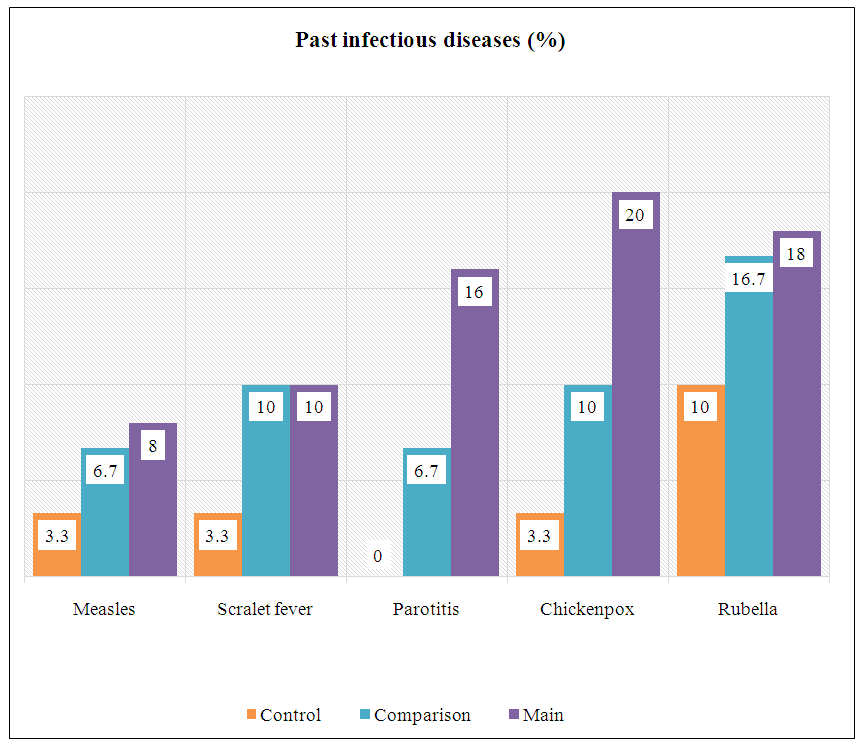 | Figure 4. Past infectious diseases |
The information presented indicates a high incidence of pathologies of an infectious nature in childhood among males from the main group, which makes this aspect one of the risk factors for dysfunction of the reproductive system in adulthood. The high incidence of mumps of the epidemic type, which is observed in males from the main group, was identified in every sixth person studied, which makes this pathology an etiopathogenetic factor in impaired fertility.In the pathogenesis of fertility disorders, morphological changes in the genital organs deserve special attention. In patients with the female factor of infertile marriage, according to palpation and ultrasound examination, no deviations in the size and structure of the testicles were registered; among representatives of the group of males with male-type infertility factor, this pathology is observed in only 4 (8%) out of 50 patients.Great importance in the development of infertility is attached to such andrological diseases as varicocele, hydrocele, hypoplasia and hypotrophy of the testicles. This pathology has a negative effect on the human reproductive system from childhood.In the men of the main group, an andrological type of disease was registered (Fig. 5), in which inflammatory processes of the genitourinary tract and the presence of varicocele dominated. Varicocele and pathologies of the inflammatory nature of the reproductive system were noted in males who were representatives of the comparison group; it is worth noting that in this group these pathologies were observed less frequently and did not occur with changes in the quality of semen. Testicular hypotrophy, in particular of secondary origin, was noted in representatives of the main group; it is worth noting that the differences with the comparison group were statistically insignificant.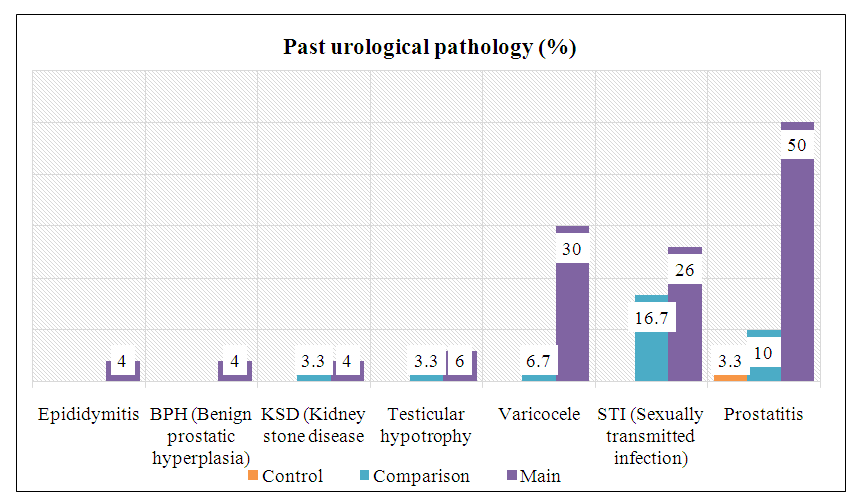 | Figure 5. Past urological pathology (history data) |
Today it is believed that one of the most common factors leading to the development of infertility in males is inflammatory pathologies affecting the accessory glands of the reproductive system (Fig. 6). The dominant role in the formation of these processes is the presence of a sexually transmitted infection. Even with an abundance of scientific work on the diagnosis of STIs in males with infertility, there are still a number of discrepancies regarding their pathogenetic role in the development of infertility.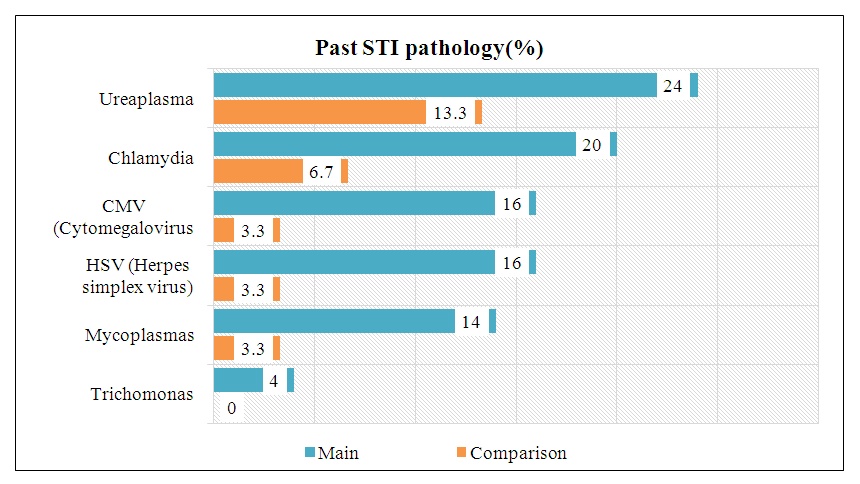 | Figure 6. Identified STIs in patients (history data) |
Evidence of the effect of the infectious factor on the state of fertility was noted when comparing the incidence of STIs in the studied males with the presence of infertility with the comparison and control groups. The information presented provides the basis for drawing a conclusion about the negative effect of STIs on male reproductive function.Special emphasis should be placed on the presence of surgical interventions on the testicles and cryptorchidism, since they have a strong effect on the reproductive system of males. According to our data, the most common type of operation is varicocele, which was undergone by 14% of men from the main group and 3.3% from the comparison group, which can be considered as one of the etiological factors of their fertility disorders. Slightly less common were operations for cryptorchidism (8%) and inguinal hernia (10%). One man with impaired fertility underwent epididytomy.Of the 80 men in infertile marriages included in the study, 62 (77.5%) men were found to have stress disorders (Fig. 7). Among them, the main group of patients prevailed - 84% of men confirmed that they were experiencing stress, and despite the fact that fewer men in the comparison group agreed with the presence of stress disorders (66.7%), the statistical difference between them was insignificant, while the difference between men in infertile marriage and the control group was significant.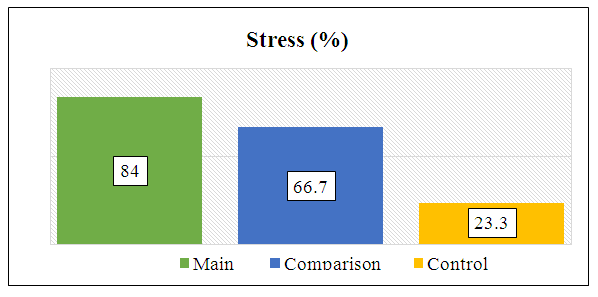 | Figure 7. Patient complaints about stress |
As we can see, in this study, the distribution of stress levels among men in infertile marriages averaged 77.5%, while the duration of infertility and unsuccessful treatment attempts were risk factors that had a statistically significant effect on stress levels. As for the average age of patients, in those who experienced stress, it was 31.1±4.8 years, (p=0.127) and this value was not a statistically significant risk factor for stress associated with infertility; education in 44% of men corresponded to higher, most of them worked in production jobs and were also drivers, but these factors also did not have a statistically significant effect.
4. Conclusions
Aggravated premorbid background and psycho-emotional disorders in the form of neurasthenia significantly prevailed in men with infertility, while the most common complaints of a neurasthenic nature were irritability, general weakness and sleep problems. When comparing men with infertility and men with female factor infertility, the former also had a higher rate, but no statistically significant difference was found.
References
| [1] | Ageikia A.V., Melnikov V.L., Karavaeva T.A., et al.//Modern opportunities for objective screening of risk factors and early diagnosis of neurotic disorders. / Review of Psychiatry and Medical Psychology named after V.M. Bekhterev. 2019. No. 4-2. pp. 52-59. |
| [2] | Devyatov D.V., Blagoveshchenskaya I.V. Features of self-esteem and AUSKONCINNY characteristics in patients with neurotic disorders. System integration in healthcare. 2019. No. 2 (44) pp. 32-37. |
| [3] | Tanatinova I.A., Mingazova E.N. Psychological aspects in the problems of infertility among the population of various countries, the text of a scientific article in the specialty “Health Sciences”. |
| [4] | Hassan H., Hassan S., Baraka M. A Survey of Relationship between Duration of Infertility and Depression among Infertile Women in Beni Suef Governorate. International Journal of Science and Research, 2015; 4(10): 1170-1177. |
| [5] | Hassan H. Infertility profile, psychological ramifications and reproductive tract infection among infertile women, in northern Upper Egypt. Journal of Nursing Education and Practice. 2016; 6(4): 92-108. https://doi.org/10.5430/jnep.v6n4p92. |
| [6] | Gamel W., Hassan H., El-ezazy A. Male Infertility and Psychological Repercussions: Α Neglected Problem in Northern Upper Egypt. International Journal of Studies in Nursing, 2019; 4(4): 1-26. doi:10.20849/ijsn.v4i4.654. |
| [7] | Hassan H., Nasr E., Mohamed S., Gooda W. Violence against infertile women: comparative study in Upper verses Lower Egypt. Nursing & Care Open Access Journal, 2023; 9(4): 168-178. DOI: 10.15406/ncoaj.2023.09.00279. |
| [8] | Abdelhalim E., Ibrahim A., Hassan H., Wahba N., Moawd S. Silent struggles: Unveiling the unspoken epidemic of domestic violence against infertile women in Egypt. International Journal of Africa Nursing Sciences, 2024, 20(100663): 1-10. https://doi.org/10.1016/j.ijans.2024.100663. |
| [9] | Hassan H. The Impact of Evidence-Based Nursing as The Foundation for Professional Maternity Nursing Practices. Open Access Journal of Reproductive System and Sexual Disorder, 2019; 2(2): 195-197. OAJRSD.MS.ID.000135. DOI: 10.32474/OAJRSD.2019.02.000135. |
| [10] | Hassan, H., Sheha, E., & Nasr, E. Level of Stress Among Pregnant Women with Heart Problems. International Journal of Research-GRANTHAALAYAH, 2016; 4(7): 220-230. http:dx.doi.org/10.5281/zenodo.58961. |
| [11] | Hassan H., Atwa A. Occupational Stress, Job Satisfaction and Cervical Screening Intention of Maternity Oncology Nurses, Medical Science & Healthcare Practice, 2017; 1(1): 48-59. doi:10.22158/mshp.v1n1p48. |
| [12] | Mohamed S., Omran A., Hanan Elzeblawy Hassan H., Ramadan E. Effect of Deep Breathing and Kegel Exercises on Stress Urinary Incontinence among Elderly Women. Benha Journal of Applied Sciences, 2023; 8(4): 81-89. DOI: 10.21608/BJAS.2023.194796.1078. |









 Abstract
Abstract Reference
Reference Full-Text PDF
Full-Text PDF Full-text HTML
Full-text HTML